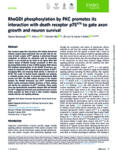In this new paper, we show how intracellular effectors RIP2 and TRAF6 compete for binding to the p75NTR intracellular domain to regulate cell death of cerebellar granule neurons.
Cerebellar granule neurons (CGNs) undergo programmed cell death during the first postnatal week of mouse development, coincident with sustained expression of the death receptor p75NTR. Although ablation of p75NTR did not affect CGN cell death, deletion of the downstream effector RIP2 significantly increased CGN apoptosis, resulting in reduced adult CGN number and impaired behaviors associated with cerebellar function. Remarkably, CGN death was restored to basal levels when p75NTR is deleted in RIP2-deficient mice. We found that RIP2 gates the signaling output of p75NTR by competing with TRAF6 for binding to the receptor intracellular domain. In CGNs lacking RIP2, more TRAF6 was associated with p75NTR, leading to increased JNK-dependent apoptosis. In agreement with this, pharmacological inhibition or genetic ablation of TRAF6 restored cell death levels in CGNs lacking RIP2. These results revealed an unexpected mechanism controlling CGN number and highlight how competitive interactions govern the logic of death receptor function.
The paper has just been published in Cell Reports.
Read the full paper HERE.


